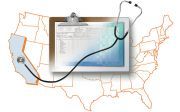Article
HHS Reports Wide Growth in Electronic Health Records Numbers
Author(s):
In just a few short years the number of doctors and hospitals using electronic health records has grown dramatically, according to the US Department of Health and Human Services.

In just a few short years, the number of doctors and hospitals using electronic health records (EHR) has grown dramatically, according to the US Department of Health and Human Services (HHS).
A statement from HHS cited studies published in Health Affairs that reported in 2013 around 78% of “office-based physicians” had some form of EHR system in operation. A little less than half reported having “advanced functionalities” as part of that system. The HHS statement reported those numbers doubled the same rates from just 4 years ago.
While smaller practices have started to go digital, the statement also noted a shift in hospital systems as well. Nearly 6 out of 10 hospitals that responded to the study reported having an advanced-function EHR system. This is a nearly 4-fold increase from the number facilities that reported having that capability in a study from 2010.
“Patients are seeing the benefits of health IT as a result of the significant strides that have been made in the adoption and meaningful use of electronic health records,” Karen DeSalvo, MD, MPH, National Coordinator for Health Information Technology, said in the statement.
With more healthcare professionals utilizing electronic systems the goal is to see that growth continue and serve patients in the most effective and efficient ways possible, according to DeSalvo.
The studies were completed ahead of the start of the acceptance and implementation of Stage 2 of the Meaningful Use of the Medicare and Medicaid EHR Incentive program. Nearly 75% of healthcare professionals and 91% of hospitals have successfully worked through Stage 1 of the process, according to HHS.
The studies also indicated that there is more work to be done, HHS reported. In 2013, only 4 out of every 10 physicians reported taking part in any health information exchanges with other providers. An even smaller number (14%) reported sharing the information with medical transport companies or hospitals.
Another potential issue identified in the studies was the fact that many hospitals surveyed said they had the technology and ability to use more of the tools in Stage 2 but had opted not to use them.
While many were not fully utilizing their technological potential, 10% did report using a number of tools including giving patients access to “view, download and transmit information about their hospital admission.”




